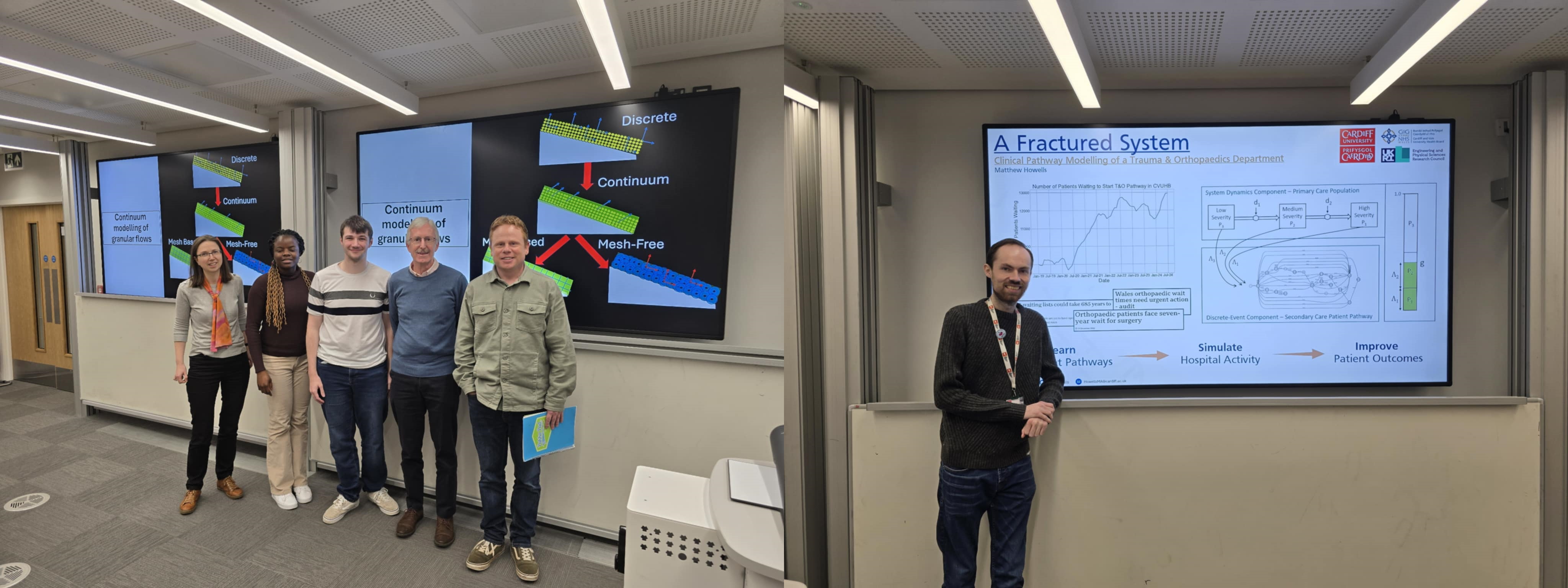Date: 30 September 2021
For our poster day we have 7 great presenters with their posters:
Name: Joshua Moore
Title: The interplay of geometry and polarity: graphical approaches to signal stability in bilayer cellular systems.
Abstract: Over the past two decades, fine-grain patterns produced by juxtacrine signalling have been
studied using static monolayers as cellular domains, where analytical results are limited to a
few cells due to the algebraic complexity of the required nonlinear dynamical systems.
Motivated by concentric patterning of Notch expression observed in the mammary gland, we
combine concepts from graph and control theory to represent cellular connectivity as a
transitional flow network. The resulting theoretical framework allows us to exploit the
symmetry of multicellular bilayer structures in 2D and 3D, thereby deriving analytical
conditions that drive the dynamical system to form laminar patterns consistent with the
formulation of cell polarity. Applying the analytic conditions to mammary organoids suggests
that intense cell signalling polarity is required for the maintenance of stratified cell-types
within a static bilayer using a lateral-inhibition mechanism. Furthermore, by employing 2D
and 3D cell-based models, we highlight that the cellular polarity conditions derived from
static domains have the capacity to generate laminar patterning in dynamic environments.
However, they are insufficient for the maintenance of patterning when subjected to
substantial morphological perturbations.
Name: Ambrose Law
Title: On Combinatorial Number Theory: Sum Systems And Their Structure
Abstract: The study of Sum Systems stem from a simple yet potent question; is it possible to find two sets of positive integers such that by taking the sum of each number in one set with each number in the other you generate the values 0,1,2,…,N for N any integer? The collection of these sets is called a Sum System and their structures are of combinatorial number theoretical interest.
Name: Yixiao Wang
Title: Deriving Word Vectors from Contextualized Language Models using Topic-Aware Mention Selection
Abstract: One of the long-standing challenges in lexical semantics consists in learning representations of words which reflect their semantic properties. The remarkable success of word embeddings for this purpose suggests that high-quality representations can be obtained by summarizing the sentence contexts of word mentions. In this paper, we propose a method for learning word representations that follows this basic strategy, but differs from standard word embeddings in two important ways. First, we take advantage of contextualized language models (CLMs) rather than bags of word vectors to encode contexts. Second, rather than learning a word vector directly, we use a topic model to partition the contexts in which words appear, and then learn different topic-specific vectors for each word. Finally, we use a task-specific supervision signal to make a soft selection of the resulting vectors. We show that this simple strategy leads to high-quality word vectors, which are more predictive of semantic properties than word embeddings and existing CLM-based strategies.
Name: Tasarla Deadman
Title: How braids can build a quantum computer
Abstract: A brief description on how Yang-Baxter representations of the Braid Group can be applied to quantum computing.
Name: Asma Irfan
Title: Interactive AI Technologies for Perceived-Value-driven Behaviour-Based Energy Management in Buildings
Abstract: The aim of Pervasive computing is to create ambience in which one’s experiences and quality of life are improved by monitoring and assisting people using ubiquitous technologies and computation in coherence. The atmospheres need computational techniques that can deal with the evolution and uncertainty of ubiquitous computing environments animatedly and automatically. We work to provide adaptive thermal comfort models developed through many studies which suggested that the dynamic thermal based behaviour of occupants can be utilized to optimize various energy influencing processes in the building.
Name: Lucy Maybury
Title: Optimising the Transition to Electric Vehicles: The UK Problem
Abstract: As decarbonisation is becoming increasingly important, many countries have placed an emphasis on decarbonising their transportation sector through electrification to support the transition to net zero. As such, many countries are transitioning from conventional vehicles to electric vehicles in their transportation sector. Mathematical modelling plays an important role in optimising a transition to electric vehicles, which is the focus of this project.
Name: Michalis Panayides
Title: The Ambulance Decision Game
Abstract: Operational Research (OR) techniques provide a toolkit of mathematical modelling approaches that are routinely used for problem solving in many sectors. Recent research shows that behavioural studies may accompany such techniques and offer some additional insight to the problem studied and thus enrich some of the already existing traditional methods. Ethnography is considered to be one of the main such approaches. Ethnographic studies have been around since the 19th century and their main guiding methodology is that a researcher that aims to study a specific social setting should acquire a deeper understanding of the cultural norms and values. The main technique that accompanies ethnography is participant observation, where the researcher participates in the social setting they wish to study recording their observations. The application of these ideas and principles considered here is the emergent behaviour that takes place at the interface between Emergency Medical Services (EMS) and the Emergency Department (ED). Numerous decisions are taken by both patients and staff alike that determine the level of workflow and the patient pathway. There is empirical evidence to suggest that imposing targets in the ED results in gaming at the interface of care between the EMS and ED. In this work, multiple scenarios are examined where an ambulance service needs to distribute patients between neighbouring hospitals. The interaction between the hospitals and the ambulance service is modelled in a game theoretic framework, supported by a novel Markov model, where the ambulance service has to decide how many patients to distribute to each hospital. This work brings together ethnography and game theory to understand the emergent behaviour in healthcare settings. The talk will present the problem being tackled at the interface of the EMS and the ED that is to be further informed by ethnographic methods.


